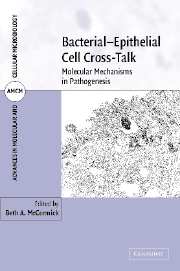Book contents
- Frontmatter
- Contents
- List of contributors
- Part I Introduction to the host and bacterial pathogens
- Part II Bacterial cell biology and pathogenesis
- Part III Host cell signaling by bacteria
- Part IV Exploitation of host niches by pathogenic bacteria: mechanisms and consequences
- 11 Lung infections
- 12 Interaction of Helicobacter pylori with the gastric mucosa
- 13 Interactions of enteric bacteria with the intestinal mucosa
- 14 Uropathogenic bacteria
- Index
- Plate section
- References
13 - Interactions of enteric bacteria with the intestinal mucosa
from Part IV - Exploitation of host niches by pathogenic bacteria: mechanisms and consequences
Published online by Cambridge University Press: 12 August 2009
- Frontmatter
- Contents
- List of contributors
- Part I Introduction to the host and bacterial pathogens
- Part II Bacterial cell biology and pathogenesis
- Part III Host cell signaling by bacteria
- Part IV Exploitation of host niches by pathogenic bacteria: mechanisms and consequences
- 11 Lung infections
- 12 Interaction of Helicobacter pylori with the gastric mucosa
- 13 Interactions of enteric bacteria with the intestinal mucosa
- 14 Uropathogenic bacteria
- Index
- Plate section
- References
Summary
INTRODUCTION
Bacteria colonize the gastrointestinal tract as early as a few hours after birth. This relationship that develops at an early stage between humans and bacteria is shared with other mammals. Gastrointestinal epithelial cells play a crucial role in maintaining a quiescent environment while being bathed with normal flora, and yet at the same time they must possess functions that allow them to participate in immune surveillance. In addition to screening for and responding to the presence of pathogens in the intestinal lumen, gastrointestinal epithelial cells provide barrier function and transport of ions and solutes.
Enteric pathogens, as opposed to normal flora, cause disease by exploiting the host cytoskeleton or signaling pathways, which ultimately alters the physiologic functions of the intestinal epithelium. For example, pathogens can induce or suppress inflammatory responses, alter the transport of fluid, solutes, and ions, perturb the tight-junction barrier, and activate programmed cell death (apoptosis). This chapter summarizes the cross-talk between bacterial pathogens and host cells that leads to gastrointestinal symptoms.
ENTERIC PATHOGENS AND INTESTINAL EPITHELIAL CELL RECEPTORS
The interaction that occurs between pathogenic or non-pathogenic bacteria and intestinal epithelial cells begins with the adherence of bacteria to the cellular surface. This is a common mechanism by which bacteria cause disease, not only in the gastrointestinal tract but also in other systems where epithelial cells face the external environment, such as the genitourinary and respiratory systems. Adherence of bacteria to the cellular surface is essential to reduce the washout effect caused by intestinal secretion and peristalsis.
- Type
- Chapter
- Information
- Bacterial-Epithelial Cell Cross-TalkMolecular Mechanisms in Pathogenesis, pp. 356 - 399Publisher: Cambridge University PressPrint publication year: 2006



